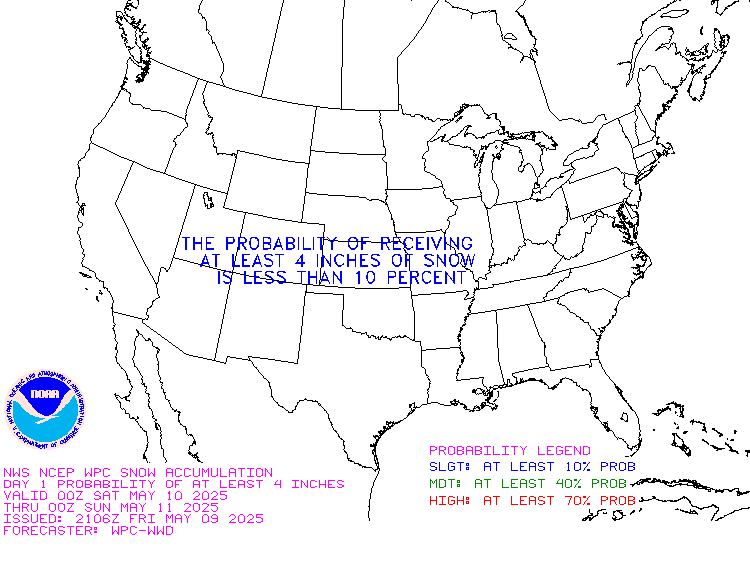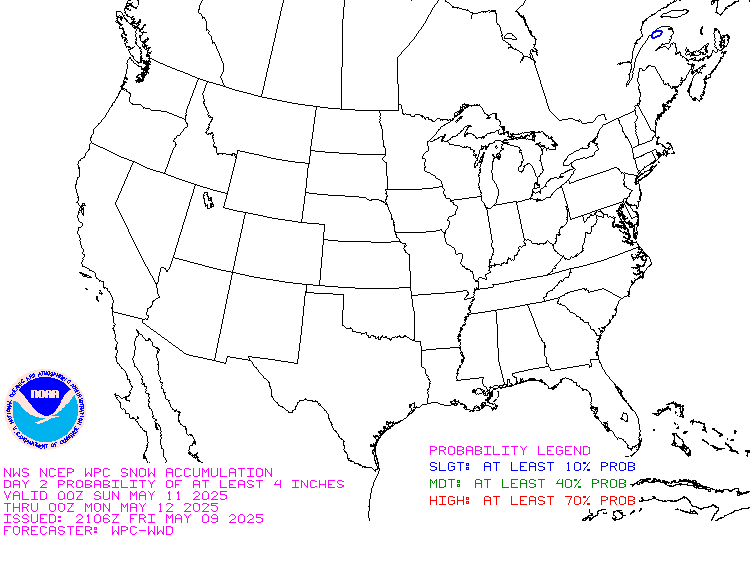This article focuses on what we are paying attention to in the next 48 to 72 hours. The article also includes weather maps for longer-term U.S. outlooks and a six-day World weather outlook which can be very useful for travelers.
First the highlights from the NWS.
Short Range Forecast Discussion
NWS Weather Prediction Center College Park MD
Fri Jan 19 2024
Valid 12Z Fri Jan 19 2024 – 12Z Sun Jan 21 2024…Another arctic air intrusion spreading into much of the central to
eastern U.S….…Heavy precipitation moving into much of California for the weekend with
heavy snow along the Sierra Nevada……Significant icing possible today and early Sunday through the Columbia
River Gorge in the Pacific Northwest……Accumulating snows spreading from the Midwest into the Mid-Atlantic…
…Lake-effect snows remain active into Saturday…
Please click on “Read More” below to access the full report issued today.
| Notices: The article on the Updated Outlook for January 2024 can be accessed HERE. What would you like to learn about? Please provide that to me via the comment section at the end of the article. |
Now more detail on the 48-Hour Forecast (It is a 48 to 72 Hour Forecast actually)
Daily weather maps. The Day 1 map updates twice a day and the Day 2 and 3 maps update only once a day. These maps update automatically. But if that does not happen, you can get updates by clicking HERE
TODAY (or late in the day the evening/overnight map will appear) (Key to surface fronts shown on maps and you will then also be able to insert a city name or zip code and get a local NWS forecast).
TOMORROW
NEXT DAY
This animation shows how things may play out over the next 60 hours. To update click here.
The NWS Climate Prediction Center’s: Watches, Warnings, and Advisories plus other information can be found HERE. We post at least one of those updates daily, sometimes both. The Highlights are shown in the lede paragraph of this article.
ATMOSPHERIC RIVERS
This tells us what is approaching the West Coast. Click HERE to update If I have not gotten around to doing the update. Here is some useful information about Atmospheric Rivers.
Continuation of the NWS Short Range Forecast. It is updated by NWS twice a day and these updates can be found here
Another surge of arctic air is currently in progress across the
mid-section of the country and then overspread the entire eastern U.S. by
this weekend. While not as cold as the previous arctic outbreak that
produced numerous records across the Plains and lower Mississippi Valley
last week, this latest arctic blast will result in sub-zero temperatures
as far south as Missouri and Kansas by Saturday morning, while wind chill
temperatures as low as -20 to -30 will be common through Sunday morning.Ahead of the arctic surge, widespread light snow associated with an
Alberta Clipper has already overspread the Midwest, Ohio Valley, and into
the central Appalachians early this Friday morning. Meanwhile, a low
pressure system is beginning to form just off the coast of the
southeastern U.S. This system is forecast to intensify rapidly as it
races off the East Coast tonight. The speed of the East Coast low will
not allow much chance for the Alberta Clipper to tap into its energy
source. Nevertheless, widespread accumulating snows associated with the
clipper are expected to quickly move into the Mid-Atlantic and southern
New England coastal section today and into this evening as the snow tapers
off across the Ohio Valley. Snowfall totals are expected to be in the
light to moderate range, generally 2 to 4 inches, with some locally
heavier totals over 6 inches in the wind-facing slopes of the central
Appalachians from eastern Kentucky/Southwest Virginia into West Virginia.
Portions of the northern Mid-Atlantic are forecast to receive amounts in
the 4 to 6 inches range while the vicinity of Cape Cod may also receive
higher amounts due to possible enhancing effects from the ocean waters.As the arctic air moves over the Great Lakes, lake effect snow showers
will be increasingly widespread downwind of the Upper Lakes today, and
then into the lower Great Lakes by Saturday. Locally heavy snows are
likely across portions of the upper peninsula of Michigan, the western
portions of the lower peninsula of Michigan, across northwest Indiana and
from northeast Ohio, across far northwest Pennsylvania into portions of
western New York State.While the central to eastern U.S. will be entrenched in much below average
arctic air, much of the western U.S. from the Rockies to the West Coast
will see above average temperatures over the next few days. In addition,
the next in the recent series of storms to move off the Pacific will bring
heavy precipitation into large portions of California beginning this
afternoon and continuing through the weekend and into early next week.The exception to above average temperatures across the West will be over
the interior Pacific Northwest from north central to northeast Oregon into
Washington State to the east of the Cascades. The western extent of the
arctic air over the Northern Plains will remain in place across these
regions. This will support potential for very dangerous icing conditions
through the Columbia River Gorge today before a lull expected to set in
this evening. However, the next surge of moisture from the next Pacific
system will likely overspread northern California with heavy rain Friday
night into Saturday. Heavy snow will then reach the Sierra Nevada
Saturday night. Scattered mixed precipitation will penetrate farther
inland into the Intermountain region by Sunday morning as more freezing
rain could impact the Columbia River Gorge once again.Learn about wave patterns HERE.
Below is the current five-day cumulative forecast of precipitation (Updates can be found HERE)
Ski SnowReports
New Feature – Ski Reports. It is difficult to find reports that auto-update on-screen (and they are very long) but these links will get you to them – If you have additional suggestions make them in the comments section after every Econcurrents Article and we may add those links. We will try to not have too much overlap as that can add to the confusion.
Snow Forecasts. And remember this shows natural snow. Ski resorts also make their own snow.
Day 1
Day 2
Additional snow information can be found here, here, here, and here. The second link provides animations.
Now we look at Intermediate-Term “Outlook” maps for three time periods. Days 6 – 10, Days 8 – 14, and Weeks 3 and 4. An outlook differs from a forecast based on how NOAA uses these terms in that an “outlook” presents information as deviation from normal and the likelihood of these deviations.
Below are the links to obtain updates and additional information. They are particularly useful if you happen to be reading this article significantly later than when it was published. I always try to provide readers with the source of the information in my articles.
Days 6 – 10 (shown in Row 1) Days 8 – 14 (Shown in Row 2) Weeks 3 and 4 (Shown in Row 3 but updates only on Fridays) https://www.cpc.ncep.noaa. gov/products/predictions/610day/ https://www.cpc.ncep .noaa.gov/products/predictions/814day/ https://www.cpc.ncep.noaa.gov/products/predictions/WK34/ Showing the actual maps. They should now update automatically. The Week 3 – 4 Outlook only updates on Fridays. So below is what I call the Intermediate-term outlook. On Fridays, it extends out 28 Days. That declines day by day so on Thursday it only looks out 22 days until the next day when the Week 3 – 4 Outlook is updated and this extends the outlook by one additional week.
6– 10
8– 14
3– 4
HAZARDS OUTLOOKS
Click here for the latest complete Day 3 -7 Hazards forecast which updates only on weekdays. Once a week probably Monday or Tuesday I will update the images. I provided the link for readers to get daily updates on weekdays. Use your own judgment to decide if you need to update these images. I update almost all the images Friday Night for the weekend edition of this Weather Report. So normally readers do not need to update these images but if the weather is changing quickly you may want to.
Temperature month to date can be found at https://hprcc.unl.edu/products/maps/acis/MonthTDeptUS.png
Precipitation month to date can be found at https://hprcc.unl.edu/products/maps/acis /MonthPNormUS.png
World Forecast [that website is temporarily not working]
Below are the Day 1 -3 and 4-6 forecasts for temperature and precipitation. Updates and much additional information can be obtained HERE
World Temperature Anomalies
World Accumulated Precipitation
This information is provided by the University of Maine. They draw upon many different sources. There is a lot of information available at the link provided. I have just provided two useful forecasts. There are probably over a hundred different forecasts available from this source.
Worldwide Tropical Forecast (This is a NOAA Product)
This graphic updates on Tuesdays) If it has not been updated, you can get the update by clicking here Readers will only have to do that if they are reading this article much later than the date of it being published.
Information on Tropical Storms can be found HERE. Western Pacific information can be found HERE.
–
I hope you found this article interesting and useful. –


